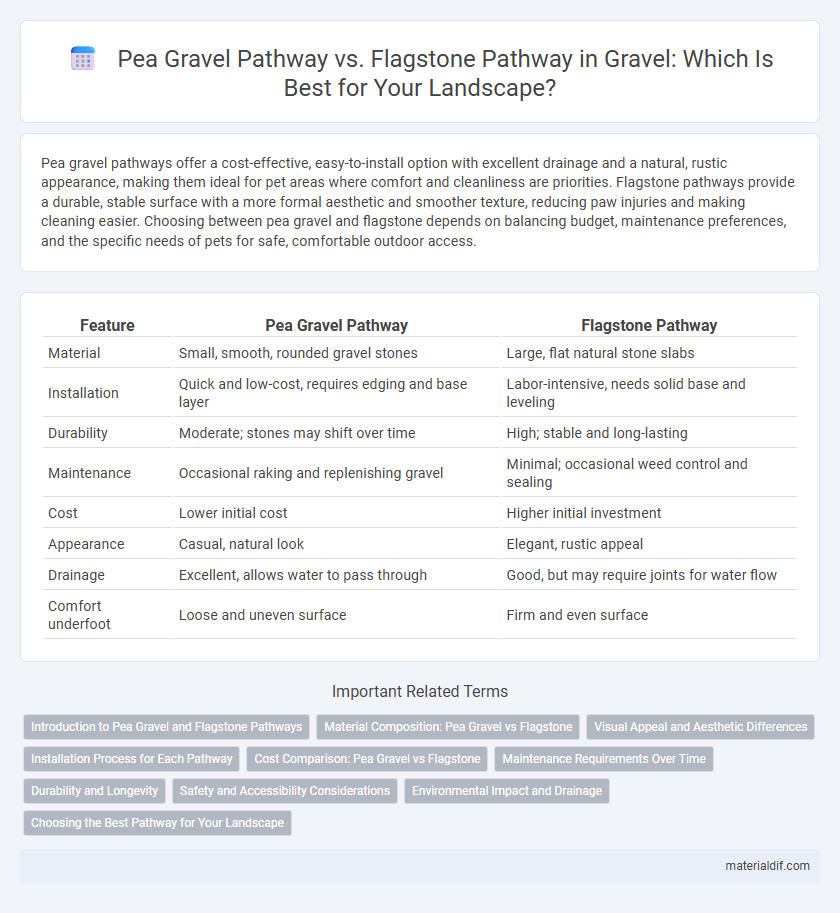Pea gravel pathways offer a cost-effective, easy-to-install option with excellent drainage and a natural, rustic appearance, making them ideal for pet areas where comfort and cleanliness are priorities. Flagstone pathways provide a durable, stable surface with a more formal aesthetic and smoother texture, reducing paw injuries and making cleaning easier. Choosing between pea gravel and flagstone depends on balancing budget, maintenance preferences, and the specific needs of pets for safe, comfortable outdoor access.
Table of Comparison
| Feature | Pea Gravel Pathway | Flagstone Pathway |
|---|---|---|
| Material | Small, smooth, rounded gravel stones | Large, flat natural stone slabs |
| Installation | Quick and low-cost, requires edging and base layer | Labor-intensive, needs solid base and leveling |
| Durability | Moderate; stones may shift over time | High; stable and long-lasting |
| Maintenance | Occasional raking and replenishing gravel | Minimal; occasional weed control and sealing |
| Cost | Lower initial cost | Higher initial investment |
| Appearance | Casual, natural look | Elegant, rustic appeal |
| Drainage | Excellent, allows water to pass through | Good, but may require joints for water flow |
| Comfort underfoot | Loose and uneven surface | Firm and even surface |
Introduction to Pea Gravel and Flagstone Pathways
Pea gravel pathways consist of small, rounded stones typically measuring 3/8 inch in diameter, prized for their natural appearance, excellent drainage, and affordability. Flagstone pathways use large, flat stones such as sandstone, limestone, or slate, providing a durable, stable surface with a rustic aesthetic ideal for garden walkways. Both options offer distinct visual appeal and functional benefits, influencing landscaping design and maintenance requirements.
Material Composition: Pea Gravel vs Flagstone
Pea gravel consists of small, smooth, rounded stones typically composed of quartz or granite, providing excellent drainage and a natural look for pathways. Flagstone is made from large, flat slabs of sedimentary rock such as sandstone, limestone, or slate, offering a sturdy and visually striking surface. The material composition influences durability, maintenance, and aesthetic appeal, with pea gravel favoring flexibility and permeability, while flagstone emphasizes solidity and decorative patterns.
Visual Appeal and Aesthetic Differences
Pea gravel pathways offer a casual, textured appearance with small, rounded stones that create a natural and informal look ideal for relaxed garden settings. Flagstone pathways provide a more polished and structured aesthetic, featuring large, flat stones with unique shapes and earthy tones that lend an elegant and timeless charm to landscapes. The choice between pea gravel and flagstone significantly impacts the visual appeal, with pea gravel emphasizing subtle movement and softness, while flagstone showcases bold patterns and a sense of permanence.
Installation Process for Each Pathway
Pea gravel pathways require a simple installation process involving laying a weed barrier fabric, adding a compacted base layer like crushed stone, and spreading the pea gravel evenly. Flagstone pathways demand more labor-intensive steps, including excavating the path area, installing a sturdy base layer such as sand or crushed stone, carefully placing each flagstone with proper spacing, and filling joints with sand or mortar for stability. While pea gravel paths offer quicker, more flexible installation, flagstone paths provide a solid, durable surface requiring precision placement and additional preparation.
Cost Comparison: Pea Gravel vs Flagstone
Pea gravel pathways typically cost between $1 to $3 per square foot, making them a budget-friendly option for landscaping projects. Flagstone pathways, on the other hand, range from $15 to $30 per square foot due to the higher price of natural stone and labor-intensive installation. The cost difference reflects materials, labor, and durability, with flagstone offering a more premium and long-lasting surface compared to pea gravel.
Maintenance Requirements Over Time
Pea gravel pathways require minimal maintenance, with occasional raking to redistribute stones and periodic topping up to replace displaced gravel. Flagstone pathways demand more consistent upkeep, including weed removal from joints, resetting stones that shift or settle, and sealing to prevent staining or erosion. Over time, pea gravel provides a low-maintenance, flexible surface, whereas flagstone offers durability but requires detailed care to maintain its appearance and stability.
Durability and Longevity
Pea gravel pathways offer flexibility and easy drainage but tend to shift and scatter over time, requiring regular maintenance to preserve their appearance and functionality. Flagstone pathways provide superior durability with large, flat stones that resist weathering and heavy foot traffic, often lasting decades with minimal upkeep. The dense composition and stability of flagstone make it a longer-lasting option compared to the loose aggregate nature of pea gravel.
Safety and Accessibility Considerations
Pea gravel pathways offer a loose, uneven surface that may pose challenges for wheelchair users and individuals with mobility impairments, increasing the risk of trips or falls. Conversely, flagstone pathways provide a stable, flat surface with minimal gaps, enhancing accessibility and safety for all users, including those with walkers or strollers. Proper installation of flagstone with firm base materials further improves traction and reduces slipping hazards in various weather conditions.
Environmental Impact and Drainage
Pea gravel pathways offer superior water permeability, reducing runoff and promoting natural groundwater recharge, which benefits surrounding ecosystems. Flagstone pathways, while visually appealing, often require mortar or compacted bases that limit drainage and can increase surface runoff, potentially contributing to soil erosion and water pollution. Choosing pea gravel enhances sustainable landscaping through improved environmental impact and efficient drainage management.
Choosing the Best Pathway for Your Landscape
Pea gravel pathways offer excellent drainage, affordability, and a natural look ideal for casual garden settings, while flagstone pathways provide durability, a stable walking surface, and a more polished aesthetic suited for formal landscapes. Consider soil type, foot traffic, maintenance level, and overall design style to determine which material aligns best with your landscape goals. Pea gravel works well in areas requiring flexibility and easy installation, whereas flagstone excels in creating defined, long-lasting walkways with a variety of customizable shapes and textures.
Pea Gravel Pathway vs Flagstone Pathway Infographic

 materialdif.com
materialdif.com